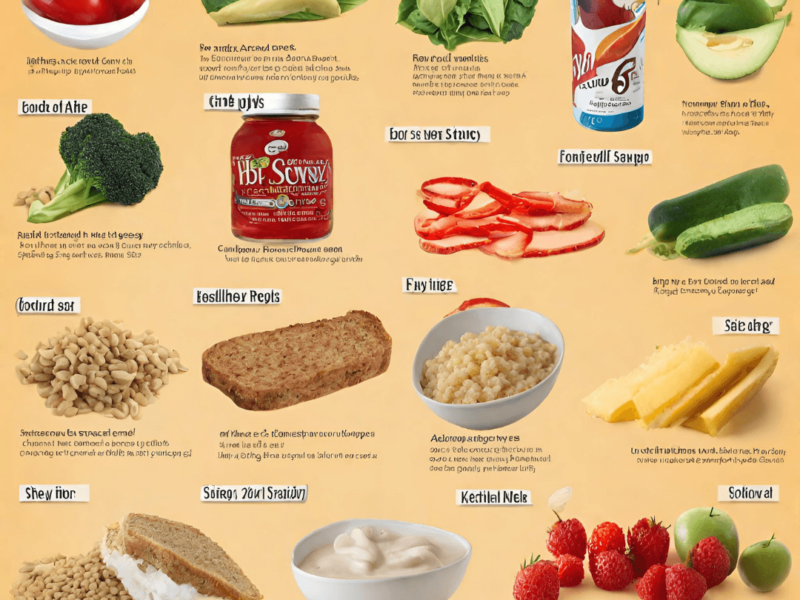Understanding and Managing Common Childhood Allergies: A Guide for Parents
Introduction
Childhood allergies can be a source of worry and stress for parents. These allergies can range from mild to severe, with symptoms that can disrupt a child’s daily life and potentially lead to serious health complications. As a parent, it is crucial to understand common childhood allergies, their causes, and how to effectively manage them. In this comprehensive guide, we will delve into the world of childhood allergies, providing you with the knowledge and tools to keep your child safe and healthy.
Types of Childhood Allergies
Childhood allergies can manifest in various ways, affecting different systems in the body. The most common types of allergies include:
Foods Allergies
Food allergies are one of the most prevalent types of childhood allergies. Some common allergens include milk, eggs, peanuts, tree nuts, soy, wheat, fish, and shellfish. Symptoms of food allergies can range from mild gastrointestinal discomfort to severe reactions like anaphylaxis, which is a life-threatening emergency.
Environmental Allergies
Environmental allergies, also known as seasonal allergies or hay fever, are triggered by exposure to allergens such as pollen, dust mites, mold spores, and pet dander. Symptoms can include sneezing, runny nose, itchy and watery eyes, and nasal congestion.
Allergic Asthma
Allergic asthma is a type of asthma triggered by allergens like pollen, dust mites, and pet dander. It can cause symptoms such as coughing, wheezing, shortness of breath, and chest tightness. If your child has a history of allergies, they may be at a higher risk of developing asthma.
Contact Dermatitis
Contact dermatitis occurs when the skin comes into contact with an allergen or irritant. Common triggers include certain fabrics, soaps, detergents, fragrances, and metals like nickel. Symptoms can include itching, redness, rash, and blisters.
Identifying Childhood Allergies
Recognizing the signs and symptoms of childhood allergies is essential for early intervention and effective management. The following indicators may suggest that your child is experiencing an allergic reaction
– Skin reactions like hives, eczema, or swelling
– Digestive issues such as vomiting, diarrhea, or abdominal pain
– Breathing difficulties like wheezing or shortness of breath
– Persistent coughing or sneezing
– Recurrent ear infections or fluid in the ears
– Behavioral changes or irritability
– Poor growth or weight loss
If you suspect that your child has an allergy, it is crucial to consult with a healthcare professional for proper diagnosis and guidance.
Diagnosing Childhood Allergies
Determining the specific allergen that triggers your child’s reaction is an important step in managing their allergies. The healthcare professional may employ various methods to diagnose childhood allergies, including:
Skin Prick Test
During a skin prick test, small amounts of common allergens are applied to the skin, usually on the forearm or back. The healthcare professional then uses a small needle to gently prick the skin, allowing the allergens to enter the body. If your child is allergic to any of the substances tested, they will develop a small red bump at the site of the prick.
Blood Test
A blood test, such as a specific IgE test, can measure the level of allergen-specific antibodies in your child’s blood. This test helps identify the presence and severity of allergic sensitization to certain substances.
Elimination Diet
In cases of suspected food allergies, an elimination diet may be recommended. This involves removing potential allergens from your child’s diet and gradually reintroducing them to identify any adverse reactions.
Medical History and Symptom Evaluation
A thorough review of your child’s medical history, as well as an evaluation of their symptoms, can provide essential clues about the presence of allergies.
Managing Childhood Allergies
Once your child’s allergies have been identified and diagnosed, effective management strategies can be implemented. It is important to work closely with your healthcare professional to develop an individualized plan tailored to your child’s specific needs. Here are some key approaches to managing childhood allergies:
Avoidance of Allergens
The primary strategy for managing childhood allergies is to minimize or eliminate exposure to allergens. For food allergies, this means carefully reading ingredient labels, avoiding cross-contamination, and notifying schools and caregivers about your child’s dietary restrictions. For environmental allergies, keeping windows closed during high pollen seasons and using indoor air purifiers can help reduce exposure to airborne allergens.
Medication
In some cases, medication may be necessary to alleviate symptoms and prevent allergic reactions. Antihistamines are commonly used to relieve itching, sneezing, and runny nose, while nasal corticosteroids can help reduce nasal inflammation. In severe cases, emergency medications like epinephrine may be prescribed to treat anaphylaxis.
Allergy Immunotherapy
Allergy immunotherapy, also known as allergy shots or sublingual immunotherapy, is an option for children with severe and persistent allergies. This treatment involves regular exposure to small amounts of allergens to desensitize the immune system and reduce allergic reactions over time.
Education and Awareness
Ensuring that your child, as well as their caregivers and teachers, are educated about their allergies is crucial for their safety. Teach your child how to recognize and avoid allergens, and provide them with allergy information cards or medical bracelets. Educate family members, friends, and school staff about emergency protocols and the proper use of emergency medications, if required.
Coping with Childhood Allergies
Dealing with childhood allergies can be an emotional journey for both parents and children. Here are some tips to help cope with the challenges that arise:
Seek Support
Connect with support groups or online communities to share experiences, advice, and emotional support with other parents facing similar situations. Talking to healthcare professionals, such as allergists or pediatricians, can also provide valuable guidance.
Educate Yourself
Take the time to educate yourself about childhood allergies, including their causes, management strategies, and available resources. The more knowledgeable you are, the better equipped you will be to support your child.
Encourage Open Communication
Maintain open and honest communication with your child, allowing them to share their concerns, fears, and any symptoms they may be experiencing. Create a safe space for them to discuss their emotions, and reassure them that their feelings are valid.
Create a Safe Environment
Implementing allergen-free zones within your home can provide your child with a safe haven. Keep their living areas clean and free of allergens, and consider investing in hypoallergenic bedding and furniture.
Prepare for Emergencies
Ensure that you and your child are prepared for allergic emergencies by always having emergency medications, such as an epinephrine auto-injector, readily available. Familiarize yourself with the signs of anaphylaxis and the appropriate steps to take in case of an emergency.
Conclusion
Understanding and managing childhood allergies is essential for the wellbeing of your child. By staying informed, working closely with healthcare professionals, and implementing effective strategies, you can provide your child with the support and care they need to thrive despite their allergies. Remember, with the right knowledge and proactive measures, you can empower yourself to navigate the challenges of childhood allergies and ensure that your child leads a happy, healthy, and allergy-free life.
Five Talented Players Solidify Roster before BSL Season Opener
Shankland’s Brace Propels Hosts to Third with 2-0 Victory over St Mirren

